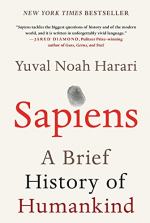
|
| Name: _________________________ | Period: ___________________ |
This test consists of 15 multiple choice questions and 5 short answer questions.
Multiple Choice Questions
1. Harari states that "When complex societies began to appear in the wake of the Agricultural Revolution, a completely new type of information became vital" (121). What was this new type of information?
(a) Numbers.
(b) Geographical information.
(c) Letters.
(d) Topographical information.
2. What does Harari NOT provide as an example of an imagined order?
(a) Christianity.
(b) Democracy.
(c) The opioid crisis.
(d) Capitalism.
3. The first mega-empires appeared in what part of the world?
(a) South America.
(b) Africa.
(c) Australia.
(d) The Middle East.
4. What does Harari NOT list as a factor that prevents "people from realising that the order organising our lives exists only in their imagination" (112)?
(a) The imagined order is embedded in the material world.
(b) The imagined order is subjective.
(c) The imagined order is inter-subjective.
(d) The imagined order shapes our desires.
5. Before the transition to agriculture, earth was home to about how many nomadic foragers?
(a) Between 6 and 12 million.
(b) Between 5 and 8 million.
(c) Between 9 and 10 million.
(d) Between 1 and 3 million.
6. The Code of Hammurabi was written in what year?
(a) 1352 BC.
(b) 1776 BC.
(c) 1352 AD.
(d) 1776 AD.
7. How long ago did the Big Bang take place?
(a) 6.5 billion years ago.
(b) 13.5 billion years ago.
(c) 80 million years ago.
(d) 45 trillion years ago.
8. Harari describes an important moment long ago when "a single female ape had two daughters. One became the ancestor of all chimpanzees, the other is our own grandmother" (5). How long ago did this occur?
(a) 2 million years ago.
(b) 6 million years ago.
(c) 30 million years ago.
(d) 9 million years ago.
9. By what year does Harari assert that "the main wave of domestication was over" (77)?
(a) 5,000 BC.
(b) 1,000 BC.
(c) 9,000 BC.
(d) 3,500 BC.
10. What is the only creature on Earth who "can speak about things that don't really exist" (24)?
(a) Chimpanzees.
(b) Neanderthals.
(c) Humans.
(d) Homo sapiens.
11. How does Harari define elements of society such as prisons and concentration camps?
(a) Republics.
(b) Phyla.
(c) Nations.
(d) Cooperation networks.
12. What is NOT provided as an example of a full script?
(a) Braille.
(b) The Hammurabi Code.
(c) Latin script.
(d) Ancient Egyptian hieroglyphics.
13. More than what percentage of the calories that feed humanity come from plants domesticated by our ancestors between 9,500 and 3,500 BC?
(a) 30.
(b) 90.
(c) 75.
(d) 60.
14. Harari asserts that "Prior to the Cognitive Revolution, humans of all species lived exclusively" (63) where?
(a) On the Afro-Asian landmass.
(b) On the landmass of the Americas.
(c) On the Austral-Asian landmass.
(d) On the Euro-Asian landmass.
15. To what object does the author refer when writing that the object represents a person trying to announce their presence to the world?
(a) A human handprint.
(b) An obelisk.
(c) A piece of pottery.
(d) A human footprint.
Short Answer Questions
1. The mammoths of Wrangel disappeared about how long ago?
2. Sapiens populated East Africa how long ago?
3. Harari asserts that most of the foragers left by the first century AD had NOT been living where?
4. What was the largest marsupial ever to walk the earth?
5. The Babylonian empire had about how many subjects during its peak?
|
This section contains 489 words (approx. 2 pages at 300 words per page) |

|




